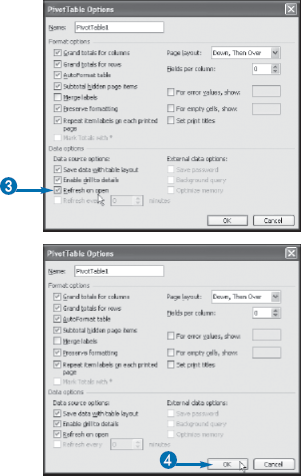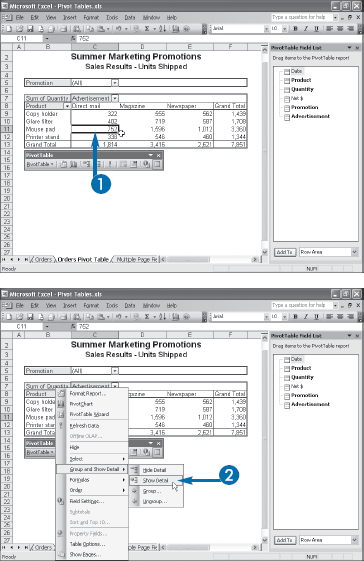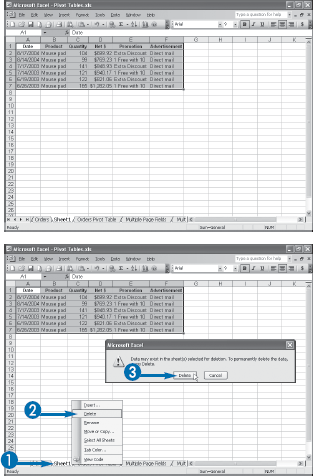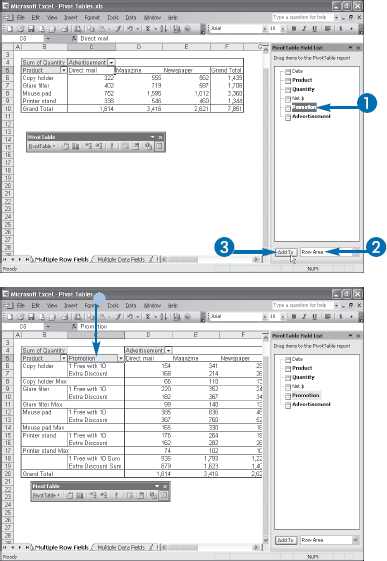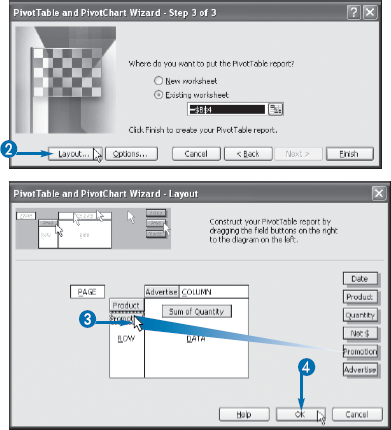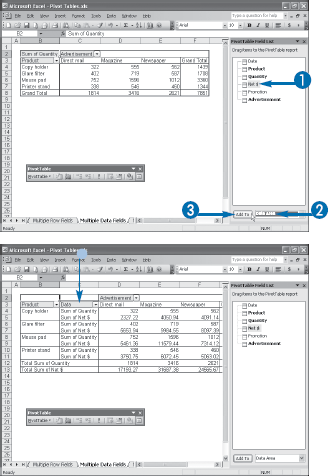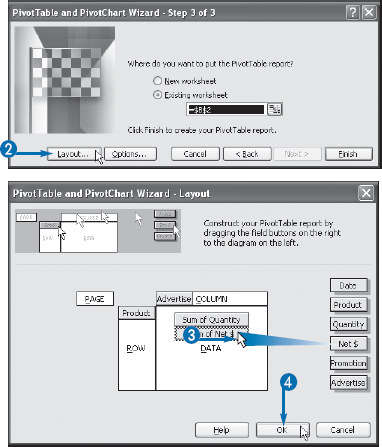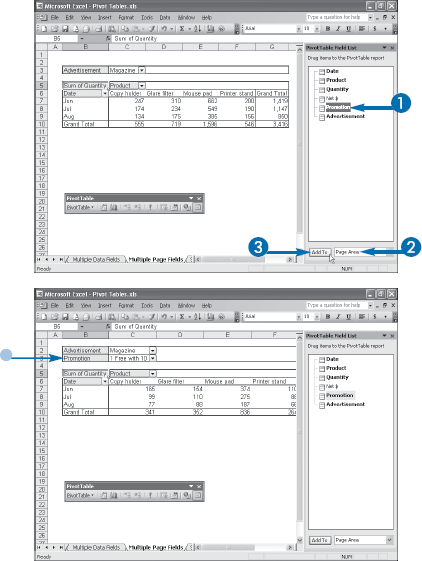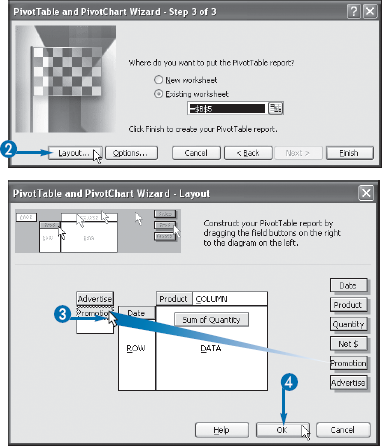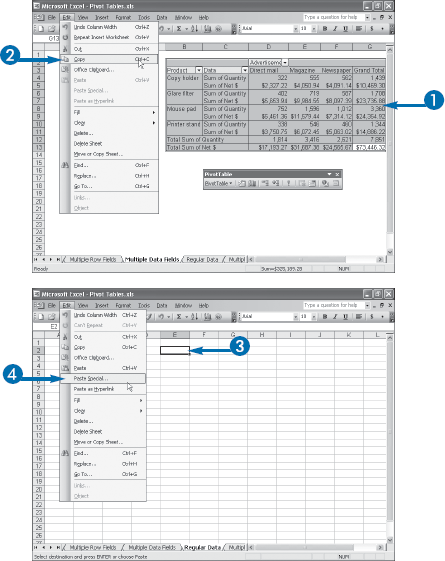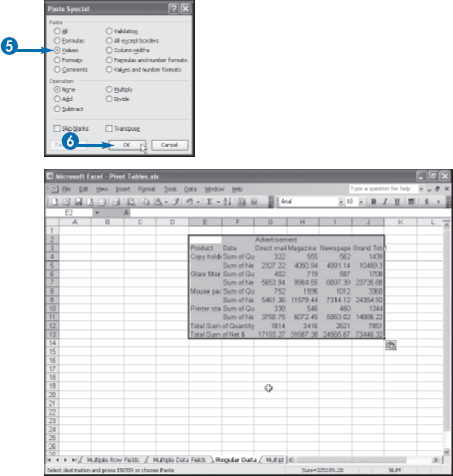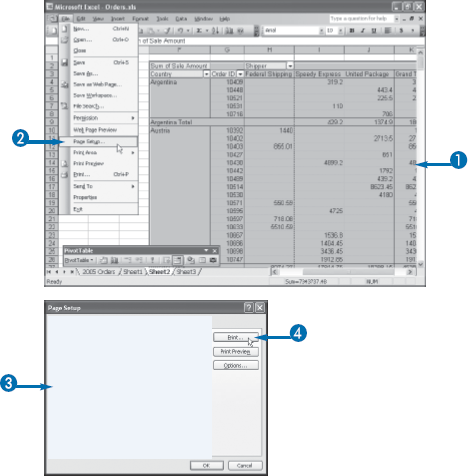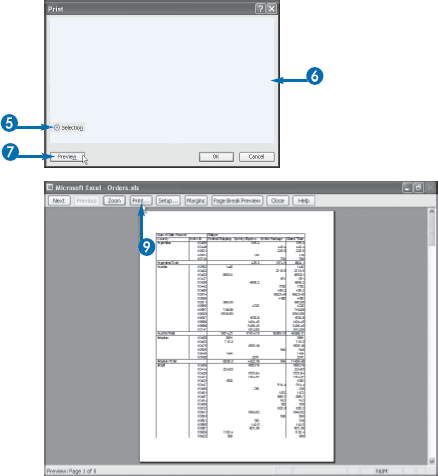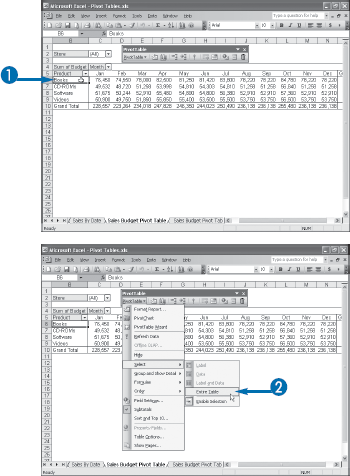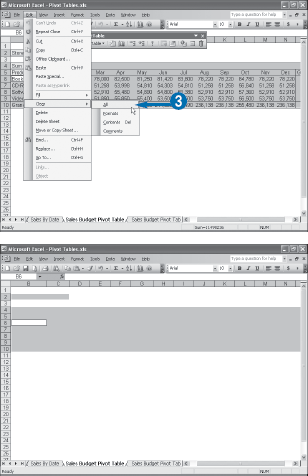You can make your PivotTable chores quicker and easier by taking advantage of the buttons on the PivotTable toolbar. Most of these buttons give you one-click access to the most PivotTable features. You can also click the PivotTable button to display a list of commands available for your PivotTables.
Normally the PivotTable toolbar appears automatically when you create a PivotTable. When you click a cell outside the PivotTable, the PivotTable toolbar disappears, and it reappears when you click a cell within the PivotTable. However, you can also turn the PivotTable toolbar on and off by hand. For example, if your PivotTable report takes up all or most of the screen, you may prefer to turn off the PivotTable toolbar to prevent it from covering any data.
Here is a summary of the most useful PivotTable toolbar buttons; each button is described in more detail elsewhere in the book:
Button | Description |
|---|---|
Displays the AutoFormat dialog box (Chapter 6) | |
Creates a PivotChart (Chapter 9) | |
Hides the detail in a group (Chapter 4) | |
Shows the detail in a group (Chapter 4); shows the underlying detail for a field or data value (Chapter 3) | |
Refreshes the PivotTable (Chapter 3) | |
Includes hidden data in totals (Chapter 8) | |
Displays unique field values as you add items to the PivotTable (Chapter 2) | |
Displays the PivotTable Field dialog box (Chapter 5) | |
Toggles the PivotTable Field List on and off (Chapter 2) |
Note
This chapter uses the Orders.xls and PivotTables.xls spreadsheets, available at www.wiley.com/go/pivottablesvb, or you can create your own sample database.
You can also click View→Toolbars→PivotTable, or right-click any toolbar or menu and then click PivotTable.
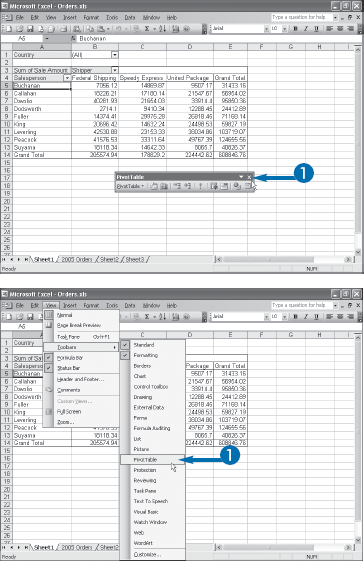
Excel turns off the PivotTable toolbar.
The buttons on the default PivotTable toolbar are very useful, but you may find that you do not use some of them very often. For example, if you never group your PivotTable data, then you will never need the Hide Detail and Show Detail buttons; see Chapter 4. You can make the PivotTable toolbar easier to work with by removing those buttons you do not use.
On the other hand, there may be PivotTable features that you use quite often, but the PivotTable does not offer a button. For example, if you often use the PivotTable and PivotChart Wizard, you have to click PivotTable→PivotTable Wizard to run it. You can save a click by adding a button for this command directly to the toolbar.
Here is a summary of the most useful extra PivotTable toolbar buttons that you can add; each button is described in more detail elsewhere in the book:
Button | Description |
|---|---|
Ungroups PivotTable data (Chapter 4) | |
Groups PivotTable data (Chapter 4) | |
Starts the PivotTable and PivotChart Wizard (Chapter 2) | |
Shows pages in separate worksheets (Chapter 4) | |
Refreshes all PivotTables in the current workbook (Chapter 3) | |
Automatically generates | |
Displays properties associated with an OLAP cube (Chapter 11) |
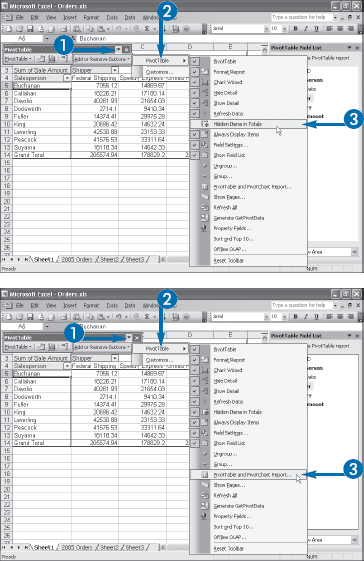
Excel displays a list of all the available PivotTable toolbar buttons.
Excel removes the check mark from beside the button and updates the toolbar.
In many of the tasks in this book, you will apply formatting or settings to some or all of the PivotTable's cells, or you will perform some action on some or all of the PivotTable's cells. Before you can do any of this, however, you must first select the cell or cells you want to work with. You can speed up your PivotTable work considerably by becoming familiar with the various methods that Excel offers for selecting elements in a PivotTable report.
If you are familiar with Excel, then you probably already know the basic techniques for selecting cells. For example, you select a single cell by clicking it, and you select a range by dragging your mouse from the top-left corner of the range to the bottom-right corner. You can also select random cells by holding down Ctrl and clicking the cells you want. You can use all the standard techniques to select cells within a PivotTable report. However, Excel also offers several methods that are unique to PivotTables. For example, you can select one or more row or column fields, just the PivotTable labels, just the PivotTable data, or the entire table. Excel also offers handy toolbar buttons for most of these techniques, so you can customize the PivotTable toolbar for one-click access to PivotTable selection techniques.
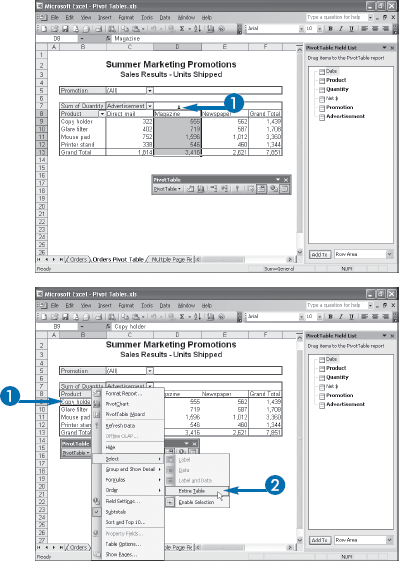
The mouse pointer changes to a black, downward-pointing arrow.
For a row, move the mouse pointer just to the left of the row label. The mouse pointer changes to a right-pointing arrow.
Excel selects the column.
From the keyboard, use the arrow keys to move the cursor into the label of the column or row.
You can also move the mouse pointer to the top or left edge of the upper-left PivotTable cell (the pointer changes to
Excel selects the entire table.
To select all the row and column fields, click any cell in a row or column field and then press Ctrl+Shift+8.
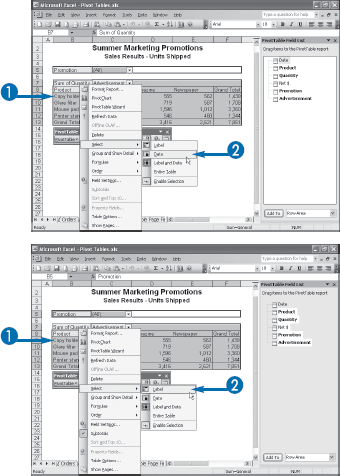
Excel selects just the PivotTable's data area.
If you select a field instead of the entire table, click PivotTable→Select→Data to select just that field's data.
After you have completed your PivotTable, the resulting report is not set in stone. You will see in Chapter 4 and in other parts of this book that you can change the PivotTable view, format the PivotTable cells, add custom calculations, and much more. You can also remove fields from the PivotTable report, as you learn in this task.
Removing a PivotTable field comes in handy when you want to work with a less detailed report. For example, suppose your PivotTable report shows the sum of sales data from four items in the Region field — East, Midwest, South, and West — that appear in the row area. This data is broken down by fiscal quarter, where each item in the Quarter field appears in the column area. If you decide you want to simplify the report to show just the total for each region, then you need to remove the Quarter field from the PivotTable.
Remove a field from a PivotTable only if you are sure you will not need the field again in the future. You can always add fields back into the PivotTable report, but deleting a field and then adding it back again is inefficient. If you only want to take a field out of the PivotTable report temporarily, consider hiding the field; see the task "Hide Items in a Row or Column Field," in Chapter 4.
Similarly, you do not need to go through the process of removing a field if you know that the field has been removed from the original data source. Instead, refresh the PivotTable and Excel will remove the deleted field for you automatically; see the task "Refresh PivotTable Data," later in this chapter.
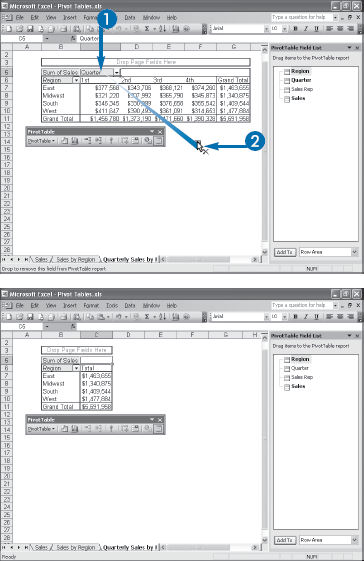
The mouse pointer changes to
Excel removes the field from the PivotTable report.
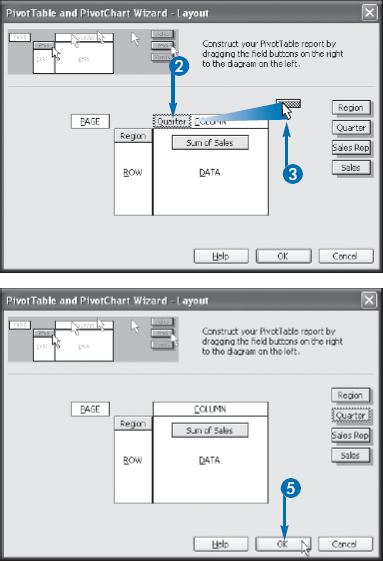
Note
To learn how to display the Layout dialog box, see the task "Add Fields Using the PivotTable Wizard" in Chapter 2.
The mouse pointer changes to
Excel removes the field from the PivotTable diagram.
Excel removes the field from the PivotTable report.
Whether your PivotTable is based on financial results, survey responses, or a database of collectibles such as books or DVDs, the underlying data is probably not static. That is, the data changes over time as new results come in, new surveys are undertaken, and new items are added to the collection. You can ensure that the data analysis represented by the PivotTable remains up to date by refreshing the PivotTable, as shown in this task.
Refreshing the PivotTable means rebuilding the report using the most current version of the source data. However, this is not the same as running the PivotTable and PivotChart Wizard over again, as described in Chapter 2 in the task "Re-create an Existing PivotTable." Instead, when you refresh a PivotTable, Excel keeps the report layout as is and simply updates the data area calculations with the latest source data. Also, depending on the type of source data you are using, Excel will remove from the report any fields that have been deleted from the source data, and it will display in the PivotTable Field List any new fields that have been added to the source data.
Excel offers two methods for refreshing a PivotTable: manually and automatically. A manual refresh is one that you perform yourself, usually when you know that the source data has changed, or if you simply want to be sure that the latest data is reflected in your PivotTable report. An automatic refresh is one that Excel handles for you. For PivotTables based on Excel ranges or lists, you can tell Excel to refresh a PivotTable every time you open the workbook that contains the report.
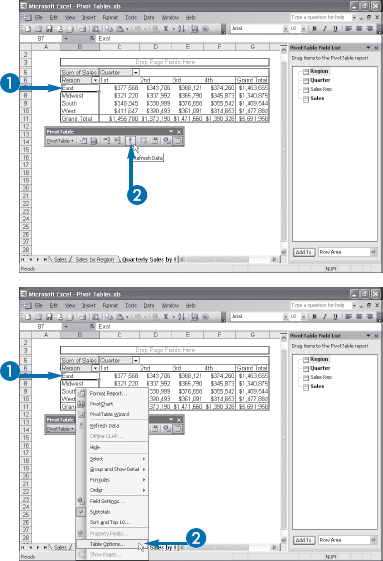
You can also select PivotTable→Refresh Data on the PivotTable toolbar. Alternatively, click Data→Refresh Data.
To update every PivotTable in the current workbook, click the Refresh All button (
Excel updates the PivotTable data.
The main advantage to using PivotTables is that they give you an easy method for summarizing large quantities of data into a succinct report for data analysis. PivotTables show you the forest instead of the trees. However, there may be times when you need to see some of the trees that comprise the forest. For example, if you are studying the results of a marketing campaign, your PivotTable may show you the total number of mouse pads sold as a result of a direct marketing piece. However, what if you want to see the details underlying that number? If your source data contains hundreds or thousands of records, you would need to filter the data in some way to see just the records you want.
Fortunately, Excel gives you an easier way to do this by allowing you to directly view the details that underlie a specific data value. This is called drilling down to the details. When you drill down into a specific data value in a PivotTable, Excel returns to the source data, extracts the records that comprise the data value, and then displays the records in a new worksheet. For a PivotTable based on a range or list, this extraction takes but a second or two, depending on how many records there are in the source data.
This task shows you how easy it is to drill down into your PivotTable data. In fact, it is so easy and so useful, that many people find themselves frequently drilling down to peek behind the data. Unfortunately, because Excel creates a new worksheet each time, this often results in a workbook that is cluttered with many extra worksheets. Therefore, this task also shows you how to delete the detail worksheets.
Excel charts are a great way to analyze data because they enable you to visualize the numbers and see the relationships between different aspects of the data. This is particularly useful in a PivotTable because it is often necessary to visualize the relationship between different columns or different rows. In Chapter 9, you learn how to create a PivotChart. However, if you just need a simple chart, or if you avoid the limitations that are inherent with a PivotChart, you can create a regular chart using the PivotTable data, as you learn in this task.
If you try to create a chart directly from a PivotTable, Excel will create a PivotChart. To create a regular chart from a PivotTable, you must first copy the PivotTable data that you want to graph, and then paste the data into another part of the worksheet. You can then build your chart using this copied data. In this case, you run through the various steps provided by the Chart Wizard to specify the chart type, chart options, and chart location.
Note, though, that this method produces a static chart. This means that if your PivotTable data changes, your chart does not change automatically. Instead, you need to re-create your chart from scratch. However, it is possible to create a dynamic chart that changes whenever your PivotTable does. See the tip on page 39 for details.
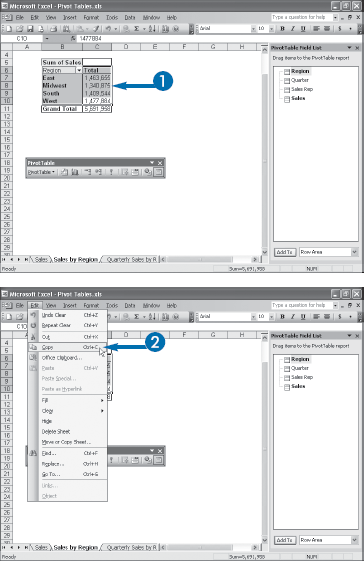
You can also press Ctrl+C or click the Copy button (
Excel copies the PivotTable data.
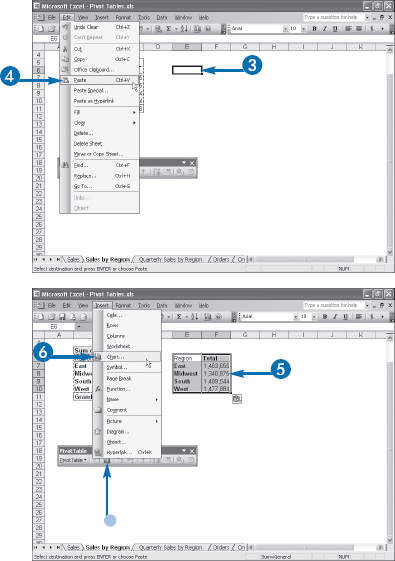
You can also press Ctrl+V or click the Paste button (
Excel pastes the copied PivotTable data.
The Chart Wizard's first dialog box appears.
As you learn in Chapter 9, a PivotChart, although very similar to a regular Excel chart, comes with a number of limitations on chart types, layout, and formatting; see the section "Understanding PivotChart Limitations". A PivotChart also comes with its own pivot cache, a concept you learned about in the tip on the previous page. This means that PivotCharts can use up a great deal of memory and can greatly increase the size of a workbook.
If you simply want to visualize your data, you can avoid the limitations and resource requirements of a PivotChart by creating a regular chart, instead. You do this by running the Chart Wizard on your copied PivotTable data. With a regular chart, you have access to all the available charting features, so you can use all the options presented by the Chart Wizard to construct your graph.
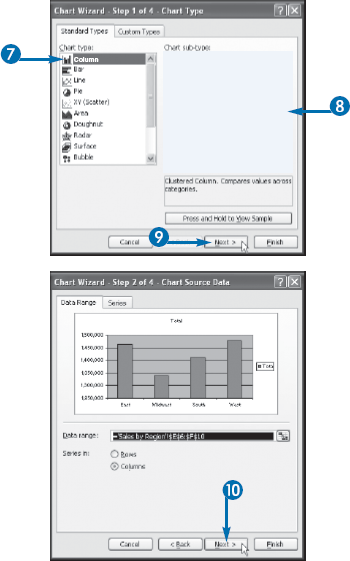
The second Chart Wizard dialog box appears.
The third Chart Wizard dialog box appears.
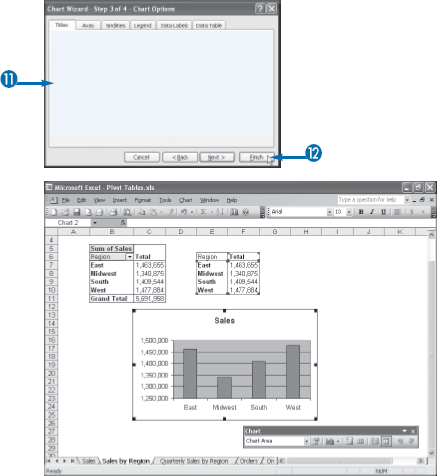
If you want to create the chart on a separate worksheet, click Next and then click "As new sheet."
Excel creates the chart.
The PivotTables you have seen so far have been restricted to a single field in any of the four areas: row, column, data, and page. However, you are free to add multiple fields to any one of these areas. This is a very powerful technique because it allows you to perform further analysis of your data by viewing the data differently.
In this task you learn how to add multiple fields to a PivotTable's row and column areas. See the next tasks, "Add Multiple Fields to the Data Area" and "Add Multiple Fields to the Page Area," as well. Adding multiple fields to the row and column areas enables you to break down your data for further analysis. For example, suppose you are analyzing the results of a sales campaign that ran different promotions in several types of advertisements. A basic PivotTable might show you the sales for each Product (the row field) according to the Advertisement in which the customer reported seeing the campaign (the column field). You might also be interested in seeing, for each product, the breakdown in sales for each promotion. You can do that by adding the Promotion field to the row area, as you see in the example used in this task.
Even more powerfully, after you add a second field to the row or column area, you can change the field positions to change the view, as described in Chapter 4 in the task "Change the Order of Fields within an Area." Note that the field in the row or column area that is closest to the data area is called the inner field and the field furthest from the data area is called the outer field.
In this task you learn how to add multiple fields to the PivotTable's data area. See also the tasks "Add Multiple Fields to the Row and Column Area" and "Add Multiple Fields to the Page Area" in this chapter. Adding multiple fields to the data area enables you to see multiple summaries for enhancing your analysis. For example, suppose you are analyzing the results of a sales campaign that ran different promotions in several types of advertisements. A basic PivotTable might show you the sum of the Quantity sold (the data field) for each Product (the row field) according to the Advertisement in which the customer reported seeing the campaign (the column field). You might also be interested in seeing, for each product and advertisement, the net dollar amount sold. You can do that by adding the Net $ field to the data area, as you see in the example used in this task.
Even more powerfully, you are not restricted to using just sums in each data field. Excel enables you to specify a number of different summary functions in the data area, so you could apply a different function to each field. For example, you could view the sum of the Quantity field and the average of the Net $ field. You learn how to change the summary function in Chapter 7 in the task "Change the PivotTable Summary Calculation."
In this task you learn how to add multiple fields to the PivotTable's page area. See also the previous tasks, "Add Multiple Fields to the Row and Column Area" and "Add Multiple Fields to the Data Area." Adding multiple fields to the page area enables you to apply multiple filters to the PivotTable to enhance your analysis. For example, suppose you are analyzing the results of a sales campaign that ran different promotions in several types of advertisements. A basic PivotTable might show you the sum of the Quantity sold (the data field) for each Product (the column field) by Date (the row field), with a filter for the type of Advertisement (the page field). You might also be interested in filtering the data even further to show specific Promotion items. You can do that by adding the Promotion field to the page area, as you see in the example used in this task.
To get the most out of this technique, you need to know how to use a page area field to filter the data shown in a PivotTable. For example, you could use the Advertisement field to display the PivotTable results for just the Magazine item. With the Promotion field also added to the page area, you could filter the PivotTable even further to display just the results for the 1 Free with 10 item. In the Chapter 4 tasks "Display a Different Page" and "Change the Page Area Layout," you learn how to display different pages and how to reconfigure the page area layout, respectively.
When you analyze data, it is often important to involve other people in the process. For example, you might want to have other people help with some or all of the analytical tasks. Similarly, you might want to share your results with other interested parties. If the other people have Excel, you can share the workload or the results simply by sending each person a copy of the workbook that contains the PivotTable. However, although Excel is extremely popular, not everyone uses it.
Whether you are sharing the work or the results, a related problem involves updates to the PivotTable data. You know you can always refresh the PivotTable to see the latest data; see the task "Refresh PivotTable Data," earlier in this chapter. However, it is inconvenient to have to send out a new copy of the workbook each time you update the PivotTable.
You can solve both problems by placing your PivotTable on a Web page, either on the Internet or on your corporate intranet site. After the PivotTable is in Web page format, anyone — even people who do not use Excel — can view the PivotTable. It is also possible to set up the Web page version of the PivotTable to be updated automatically whenever you save the original workbook, so other people always see the latest data. Finally, you can also create interactive PivotTables, which means that other people can work with the PivotTable within the Web browser. This task shows you the steps involved in publishing a PivotTable to a Web page.
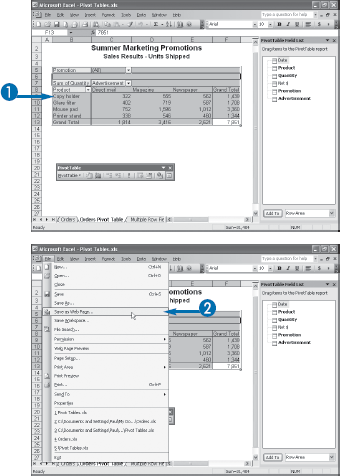
The Save As dialog box appears.
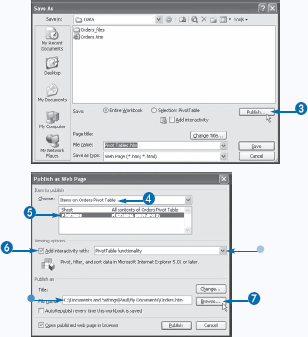
The Publish as Web Page dialog box appears.
The Publish As dialog box appears.
When publishing a PivotTable, it is important to choose the proper location for the published Web page and its associated files. If you will be putting the PivotTable Web page on an Internet site, you should save the Web page to whatever folder you use for your other Web site files, which will likely be a subfolder of My Documents. If you will be putting the PivotTable Web page on your corporate intranet site, you should save the Web page to an appropriate network folder. Ask your system administrator for the correct folder and whether you need a username and password.
After you publish an Internet-based PivotTable Web page to your computer, you must then use an FTP utility or similar program to upload the Web page and its associated files to your directory on the Web server. You can save this extra step by specifying the particulars of your FTP sites within Excel, as described in the tip on the following page.
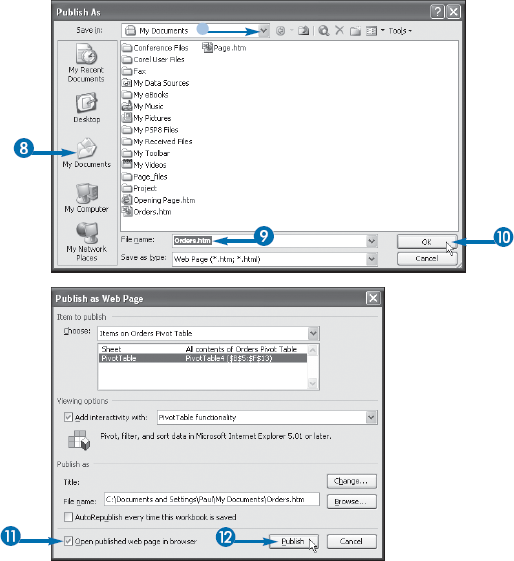
Note
When typing a name for the Web page, do not use spaces and make sure the name ends with either .htm or .html.
Excel returns you to the Publish as Web Page dialog box.
Excel publishes the PivotTable to the Web page.
If you are running Windows XP Service Pack 2 or later, Internet Explorer warns you that it has prevented the file from showing active content.
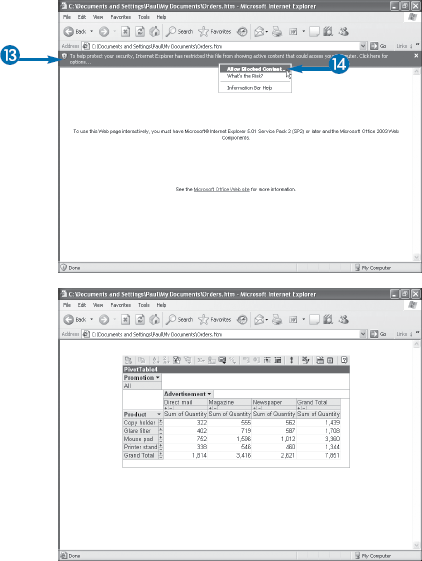
Internet Explorer displays a dialog box asking if you are sure you want to run the active content.
Internet Explorer displays the PivotTable on the Web page.
One of the major drawbacks of PivotTables is that they often require an inordinate amount of system resources. For example, it is not unusual to have source data that contains a large number of records or to have a PivotTable that is itself quite large and uses multiple fields in one or more areas. In such cases, the workbook containing the PivotTable can become huge and the memory used by Excel to store PivotTable data for faster performance can become excessive.
In situations where you need to manipulate the PivotTable frequently and where the source data changes, you have no choice but to put up with the burden that the PivotTable puts on your system. On the other hand, you may just be interested in the current PivotTable results and have no need to manipulate or refresh the data; similarly, you may not even need to keep the source data after you have built your PivotTable. In these scenarios, you can drastically reduce the resources used by the workbook by converting your PivotTable into regular data. When you have done that, you can delete the PivotTable — see the task "Delete a PivotTable," later in this chapter — and the source data, assuming the source data is an Excel range or list that you no longer need.
PivotTables are mostly useful in electronic format where you can perform the manipulations that you have learned about in this chapter, as well as change the PivotTable view to enhance your analysis of the data. See Chapter 4 to learn how to change the PivotTable view.
However, after you complete the PivotTable, you might want to preserve a hard copy by printing out the PivotTable report. You can use the printout to send a copy to another person, store the report in a file, or provide a backup if you lose the original electronic report or if the original report is no longer available.
Printing the PivotTable is also useful for documenting intermediate steps in the data analysis. If your analysis consists of four or five changes to the PivotTable, you could get a printout at each stage to document what you have done.
Printouts are also useful for comparing PivotTable results side by side. For example, you could construct the PivotTable using one layout and then print it out. You could then change the PivotTable layout and get a second printout. With the two printouts beside each other, you can then quickly scan the reports to compare them.
PivotTables are useful data analysis tools, and now that you are becoming comfortable with them, you may find that you use them quite often. This will give you tremendous insight into your data, but that insight comes at a cost: PivotTables are very resource-intensive, so creating many PivotTable reports can lead to large workbook file sizes and less memory available for other programs. You can reduce the impact that a large number of open PivotTables have on your system by deleting those reports that you no longer need.
Even if you create just a few PivotTables, you may find that you need them only temporarily. For example, you may just want to build a quick-and-dirty report to check a few numbers. Similarly, your source data may be preliminary, so you might want to create a temporary PivotTable for now, holding off on a more permanent version until your source data is complete. Finally, you might build PivotTable reports to send them to other people. When that is done, you might no longer need the reports yourself. For all these scenarios, you need to know how to delete a PivotTable report, and this task shows you how it is done.

